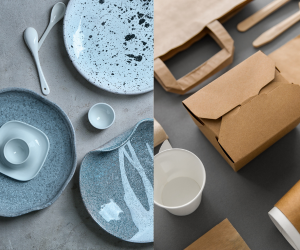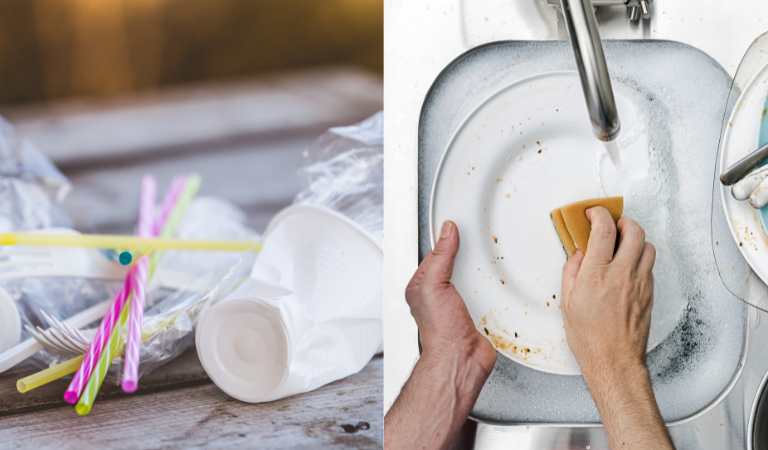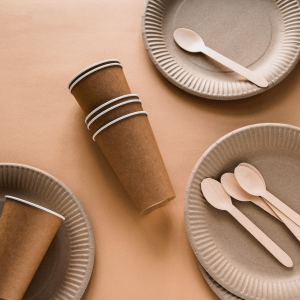When it comes to planning a catering event, the choice of using disposable or reusable tableware is significant. Both types have their unique perks and can contribute differently to the aesthetic of your event and its environmental footprint.
In essence, the decision between disposable and reusable tableware depends on the nature of the event, your budget, aesthetic preferences, and sustainability considerations. Our all-inclusive, straightforward guide on choosing disposable or reusable tableware for catering can provide helpful insights and lead you towards an informed decision, best suited to your catering needs.

Disposable Tableware
Disposable tableware, which includes items likeplastic plates and plastic cutleryhas gained immense popularity in recent years. It's undeniably convenient, especially for picnics, parties, and events. However, let's consider the factors that make it appealing and the drawbacks it brings.
What Are The Advantages And Disadvantages Of Disposable Tableware?
Advantages Of Disposable Tableware
The aspect of hygiene is often overlooked when talking about disposable tableware. Still, it's an important factor, especially in situations where large gatherings take place or where sanitation cannot be ensured fully.
Single-Use Principle
Disposable tableware operates on the single-use principle, which means that once it has served its purpose, it is discarded. This reduces the possibility of pathogen transfer from one user to another, as would be the risk with improperly cleaned reusable tableware. It ensures that each individual gets a clean plate free of remnants from prior uses.
Prevention Of Foodborne Illnesses
Disposable tableware reduces the risk of foodborne illnesses precipitating through cross-contamination. For example, in buffet-style meals where everyone is sharing communal dishes, having disposable spoons or forks for each serving dish can prevent the transfer of germs between different people.
Ideal For Community Events
For large community events or public food service locations where numerous people are involved, maintaining consistent cleanliness of reusable tableware can be challenging. Disposable tableware can circumvent this issue, providing a sterile eating apparatus for each individual, thereby mitigating the spread of infections.
While the merits of disposable tableware do not altogether remove the need for proper food handling and sanitation practices, they undoubtedly offer an added layer of protection. In settings where higher hygiene standards are required or where cleaning facilities are limited, disposable tableware can be a beneficial, safe, and convenient choice.
Disadvantages Of Disposable Tableware
While it might seem like disposable tableware is cheaper to use because individual items don't cost much, this can lead to a misconception. The truth unfolds when you consider the frequency of usage.
Frequent Buying Cycles
If you host regular events and parties, or if you're using disposable tableware for daily meals, the costs can quickly add up. Unlike reusable tableware, which requires a one-time purchase, disposable tableware must be constantly repurchased. Over time, these recurrent costs surpass the one-time expense of investing in reusable tableware.
Waste Management Costs
In addition to frequent procurement costs, there's the often-overlooked aspect of waste management. A high usage of disposable tableware leads to more household waste. Some communities charge for waste disposal on a scalable measure, so the more you throw out, the more you have to pay.
Hidden Environmental Costs
While it might not directly impact our pockets, we can't disregard the indirect costs that come with environmental pollution. The maintenance of landfills, recycling efforts, and even damage control after pollution-related disasters have fiscal consequences that are shouldered by the community as a whole.
A crucial recognition is that the 'disposable' nature of such tableware can lead to a cycle of frequent purchases and growing disposal rates. It seems cost-effective in the short term, but when calculated over longer periods like a year, the costs, both direct and indirect, can be quite surprising. This is how, even without noticing, disposable tableware can become more expensive than reusable ones in the long run.

Reusable Tableware
Reusable tableware refers to items such as plates, bowls, cutlery, and glassware that can be used multiple times instead of being discarded after a single use. This tableware can be made from various durable materials like metal, glass, bamboo, or heavy-duty plastic. Let’s analyze both the attractive aspects as well as the potential negatives attached to reusable tableware.
What Are The Advantages And Disadvantages Of Reusable Tableware?
Advantages Of Reusable Tableware
On the other side of the table, we have reusable tableware. This includes items like ceramic plates, glassware, and stainless steel cutlery. Reusable tableware has its own set of advantages and disadvantages.
On the other side of the table, we have reusable tableware. This includes items like ceramic plates, glassware, and stainless steel cutlery. Reusable tableware has its own set of advantages and disadvantages.
Minimizing The Frequency Of Purchases
One primary factor that makes reusable tableware more cost-effective in the long run is its sheer durability and longevity. High-quality ceramic plates, stainless steel cutlery, and glass cups are designed to withstand long-term use.
By avoiding the need for recurrent tableware procurement, you can save significant costs on an ongoing basis. As opposed to single-use disposable tableware, which requires constant replenishment, reusable tableware eliminates the need for frequent purchases, becoming wallet-friendly over an extended period.
Investing In Quality
Though the initial outlay for reusable tableware is higher than the cost of disposables, you're investing in the quality of the items you utilize. This means that you'll have a more enjoyable dining experience, which could lead to increased satisfaction and happiness within your household or organization. Moreover, the apparent elegance and style of reusable tableware enhance the overall aesthetic of your events or gatherings. This appearance of quality comes in handy during business meetings or special occasions, leaving a lasting impression on guests.
The True Measure Of Costs
Evaluating cost-effectiveness relies on examining the total cost of ownership (TCO) of the tableware. TCO includes not only the initial purchase price but also any additional costs incurred over the lifetime of the items. In the case of reusable tableware, the TCO often proves to be lower than disposable options when you consider the long-term savings.
Evaluating cost-effectiveness relies on examining the total cost of ownership (TCO) of the tableware. TCO includes not only the initial purchase price but also any additional costs incurred over the lifetime of the items.
Disadvantages Of Reusable Tableware
While we've discussed the numerous advantages of reusable tableware, no product is without its shortcomings. It's essential to understand these challenges to make the most informed decision when choosing tableware.
High Water Usage For Cleaning
One primary drawback of using reusable cutlery lies in the substantial water usage for the cleaning process. Unlike disposable utensils that can be discarded after a single use, reusable cutlery requires regular, thorough washing after each usage, which can lead to increased water consumption. This additional water usage can significantly raise utility costs, particularly for large-scale operations. Furthermore, alongside everyday use, routine cleaning of these utensils may necessitate additional water, which in turn results in steep water consumption.
Moreover, cleaning reusable cutlery often involves the use of detergents or cleansing agents resulting in the production of graywater. While graywater can be recycled, it demands an extra step, which is avoided with the use of disposable utensils. Additionally, the need for heated water to sanitize the utensils effectively also increases energy consumption, leading to an overall increase in operational costs. In regions suffering from water scarcity, the constant use of water for cleaning reusable cutlery could pose a significant strain on already limited water resources, thereby making this an environmentally unsound choice.
Maintenance
One of the main concerns with reusable tableware is the requirement for regular maintenance. Unlike disposable tableware, which can be simply thrown away after use, reusable items like plates, glasses, and cutlery need proper drying after each use. This process can be time-consuming. In addition, it adds a layer of household chores, making it a potential inconvenience for busy individuals or organizations. For those with access to dishwashers, it does simplify the process, but it still requires energy
The ongoing care and maintenance of these items might involve periodic polishing or upkeep to ensure they remain in good condition and maintain their original appearance, adding further to the responsibility that comes with owning reusable tableware.
Breakage Risk
Another downside of reusable tableware is the risk of breakage or damage. Since many reusable tableware items are made from ceramic, porcelain, or glass, they are susceptible to breakage from accidents, including dropping or mishandling. This can be an issue in households with young children, who may inadvertently break items. In some cases, the replacement costs for individual items or entire sets of tableware can be quite high.
Furthermore, even highly durable material like stainless steel is not immune to potential damage. For instance, cutlery from this material can be prone to scratches and dents over time. In some cases, this might affect the appearance or usability of the items, potentially leading to a need for replacement.
Which Type Of Tableware Is The Best For Catering?
Deciding on what type of tableware is best for catering, whether on-site or off-site, is a highly specific task and depends on your catering business's needs, clientele preferences, and environmental commitments.
For high convenience and hygiene standards, especially during large events or for catering businesses serving a vast number of customers, disposable tableware might be the best option. It offers ease of use and straightforward cleanup, making it ideal for off-site catering situations. Moreover, it significantly minimizes the risk of spreading germs, ensuring a safe dining experience for your patrons.
However, if your catering service is dedicated to preserving the environment and aims to reduce waste, reusable tableware may be a fitting choice, even at on-site events. Though it involves more maintenance and careful handling, choosing reusable tableware significantly curtails the amount of single-use waste your business generates. It also publicly underscores your commitment to environmental stewardship, making a positive impression.
Cost is also a critical consideration in decision-making. At first glance, disposable tableware might seem cost-effective, but the recurring costs can accumulate, particularly for a large-scale catering operation. In contrast, while reusable tableware may involve a higher initial investment, it can result in long-term savings.
The optimal tableware for your catering business will harmonize with your operations, ethos, financial parameters, and environmental considerations. It's advisable to consult your team in this decision, as it not only impacts their work but also ensures their involvement in the successful implementation of the chosen approach.
How To Choose The Best Tableware?
So, how do you decide which type of tableware is best for your needs? Here are some key considerations to help you make the right choice:
- Frequency of Use: If you frequently host gatherings or events, disposable tableware is convenient. For daily meals, reusable options can be more cost-effective.
- Environmental Impact: If you're concerned about the environment, reusable tableware is the winner. It helps reduce the staggering amount of waste generated by disposables.
- Cost: While disposable tableware appears cheaper upfront, the long-term costs can be higher. Reusable tableware pays off in the long run.
- Aesthetics: Reusable tableware often wins in appearance and style, making it a great choice for special occasions.
- Convenience: If you're looking for a quick cleanup, disposable tableware is unbeatable.
How To Make Your Disposable Tableware More Sustainable?
Making disposable tableware more sustainable is essential for reducing environmental impact. Here are some steps you can take to make your use of disposable tableware more eco-friendly:
- Choose compostable tableware: Opt for tableware made from compostable materials such as sugarcane or bamboo. These items break down more easily in composting systems, reducing landfill waste.
- Look for biodegradable options: Seek out tableware labeled as biodegradable. Biodegradable items break down naturally over time without harming the environment.
- Reduce single-use plastics: Use fewer single-use plastic items like straws, cutlery, and cups. Switch to reusable options whenever possible, or choose eco-friendly alternatives.
- Recycle when possible: If you must use disposable plastic or paper tableware, ensure it is recyclable and dispose of it properly in recycling bins.
- Educate and encourage others: Share your knowledge about sustainable disposable tableware with friends and family. Encourage them to make more eco-friendly choices as well.
- Support sustainable brands: Choose products from brands that prioritize sustainability in manufacturing and packaging.
- Participate in composting programs: If your community has composting programs, participate by disposing of your compostable tableware there.
By adopting these practices, you can make disposable tableware more sustainable and contribute to a healthier planet. Reducing waste and choosing eco-friendly alternatives are steps in the right direction.
Make Your Choice!
In the battle of disposable vs. reusable tableware, it's clear that the latter is the more environmentally responsible choice. Reusable tableware not only reduces waste but also offers long-term savings.
However, there are situations where disposables are unavoidable due to their convenience. In these instances, the focus should shift to sustainable disposable options. Compostable and biodegradable materials provide eco-friendly alternatives that break down naturally, reducing the strain on landfills. By choosing these materials and minimizing single-use plastics, you can reduce the environmental impact while enjoying the ease of disposable tableware.
Ultimately, the choice between disposable and reusable tableware is a matter of personal preference and circumstance. While convenience is crucial in the field of catering, being mindful of the environment and considering the long-term impact of your choices is equally important. So, no matter the event, choose your tableware wisely and enjoy your meal with a clear conscience.









